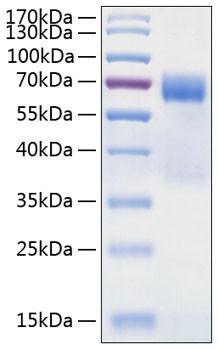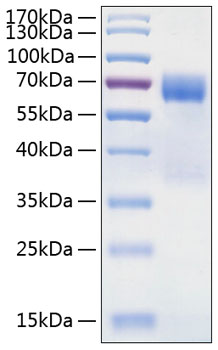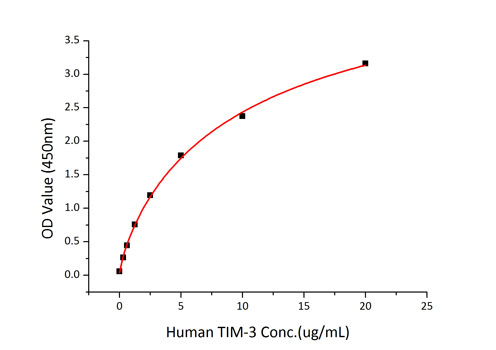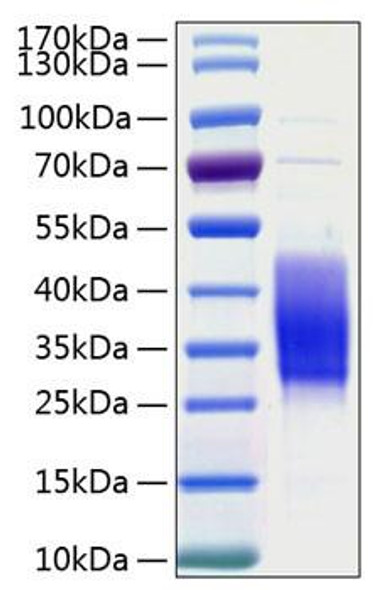Description
Recombinant Human TIM-3/HAVCR2/CD366 Protein
The Recombinant Human TIM-3/HAVCR2/CD366 Protein is a biologically active recombinant protein that plays a significant role in various cellular processes and signaling pathways in human biology. This protein is widely employed in immunological research, cell biology studies, protein-protein interaction analyses, and therapeutic development, providing researchers with a reliable tool for investigating TIM-3/HAVCR2/CD366 function and its implications in health and disease.
This product (SKU: RPCB0318) is produced using HEK293 cells and features a C-hFc&His tag for convenient detection and purification. The protein exhibits a calculated molecular weight of 46.66 kDa with an observed molecular weight of 65-75 kDa under denaturing conditions, achieving ≥ 85 % as determined by SDS-PAGE.. Functional bioactivity has been validated through rigorous quality control assays, confirming its suitability for demanding research applications.
Key Features
| High Purity by Affinity Chromatography | |
| Mammalian & Bacterial Expression Systems | |
| High lot-to-lot consistency via strict QC |
| Product Name: | Recombinant Human TIM-3/HAVCR2/CD366 Protein |
| SKU: | RPCB0318 |
| Size: | 10 μg , 20 μg , 50 μg , 100 μg |
| Reactivity: | Human |
| Synonyms: | HAVCR2, CD366, HAVcr-2, KIM-3, TIM3, TIMD-3, TIMD3, Tim-3, CD366, KIM-3, SPTCL, TIMD3, Tim-3, TIMD-3, HAVcr-2 |
| Tag: | C-hFc&His |
| Expression Host: | HEK293 cells |
| Calculated MW: | 46.66 kDa |
| Observed MW: | 65-75 kDa |
| Gene ID: | 84868 |
| Protein Description: | High quality, high purity and low endotoxin recombinant Recombinant Human TIM-3/HAVCR2/CD366 Protein (RPCB0318), tested reactivity in HEK293 cells and has been validated in SDS-PAGE.100% guaranteed. |
| Endotoxin: | < 0.1 EU/μg of the protein by LAL method. |
| Purity: | ≥ 85 % as determined by SDS-PAGE. |
| Formulation: | Lyophilized from a 0.22 μm filtered solution of PBS, pH 7.4.Contact us for customized product form or formulation. |
| Bio-Activity: | Measured by its binding ability in a functional ELISA. Immobilized Recombinant Human Galectin9 at 2 μg/mL can bind recombinant human HAVCR2 with a linear range of 0.3-5 μg/mL. |
| Reconstitution: | Centrifuge the vial before opening. Reconstitute to a concentration of 0.1-0.5 mg/mL in sterile distilled water. Avoid vortex or vigorously pipetting the protein. For long term storage, it is recommended to add a carrier protein or stablizer (e.g. 0.1% BSA, 5% HSA, 10% FBS or 5% Trehalose), and aliquot the reconstituted protein solution to minimize free-thaw cycles. |
| Storage: | Store at -20℃.Store the lyophilized protein at -20℃ to -80 ℃ up to 1 year from the date of receipt. After reconstitution, the protein solution is stable at -20℃ for 3 months, at 2-8℃ for up to 1 week. |
HAVCR2 also known as TIM3(T cell immunoglobulin and mucin domain-3), is a 60 kDa member of the TIM family of immune regulating molecules. TIMs are type I transmembrane glycoproteins with one Ig-like V-type domain and a Ser/Thr-rich mucin stalk region. Mature human TIM-3 consists of a 181 amino acid (aa) extracellular domain (ECD), a 21 aa transmembrane segment, and a 78 aa cytoplasmic tail. An alternatively spliced isoform is truncated within the mucin-like stalk.TIM-3 is up‑regulated on several populations of activated myeloid cells (macrophage, monocyte, dendritic cell, microglia, mast cell) and T cells (Th1, CD8+, NK, Treg). Its binding to Galectin-9 induces a range of immunosuppressive functions which enhance immune tolerance and inhibit anti-tumor immunity. TIM-3 ligation attenuates CD8+ and Th1 cell responses and promotes the activity of Treg and myeloid derived suppressor cells. In addition, dendritic cell-expressed TIM-3 dampens inflammation by enabling the phagocytosis of apoptotic cells and the cross-presentation of apoptotic cell antigens. It also binds the alarmin HMGB1, thereby preventing the activation of TLRs in response to released tumor cell DNA. TIM-3 interactions with Galectin-9 can alternatively trigger immune stimulatory effects, such as the coactivation of NK cell cytotoxicity.








